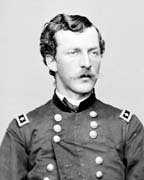Labor and Race Relations
You are at Home -> Labor and Race Relations -> Nelson A. Miles, CommandingNelson A. Miles, Commanding

Nelson A. Miles |

General Nelson A. Miles |
The Civil War
Miles served in many of the bloodiest campaigns of the Civil War. He served on the staff of General Howard during the Peninsula Campaign, and was severely wounded at the battle of Fair Oaks in May, 1862. He recovered to lead a unit as a Lieutenant Colonel at the battle of Antietam. Promoted to full Colonel, he fought at Fredericksburg and Chancellorsville. As a result of his actions at the battle of Chancellorsville, he received the Congressional Medal of Honor. He then was part of General Grant's overland campaign. By the time of the siege of Petersburg, in 1864, Nelson had been promoted to Brigadier General at the age of 26.A Most Famous Prisoner
After the war, he commanded Fort Monroe in Virginia. Part of the Fort was also a prison camp. His most famous prisoner was Jefferson Davis, former President of the Confederacy. The deplorable conditions that the prisoners were housed in, particularly Davis' condition of being shackled to a wall night and day in a filthy cell, led to a public outcry and one of the first attempts by the U.S. at codifying the treatment of prisoners.The Indian Campaigns
In 1869, Miles commanded the 5th U.S. Infantry, which guarded the frontier territories of Utah, Texas, New Mexico, and Arizona. Miles' brutally effective campaign strategies resulted in numerous victories over the Cheyenne, Comanche, Kiowa, and Arapaho. After the death of his friend, George Armstrong Custer, Miles took over command of the Yellowstone area.Defeat of Crazy Horse
Crazy Horse, respected leader of the Lakota Sioux, was defeated at the Battle of Wolf Mountain in 1877 in the Montana Territory. He surrendered to Miles' forces on May 5 at Camp Robinson in Nebraska.Chief Joseph and the Nez Perce War
Soon after Crazy Horse was defeated and surrendered, Miles turned his attention to the Nez Perce, led by Chief Joseph, who had recently crossed into the Montana Territory with a strong and undefeated band of seasoned warriors. On October 5, 1877, Miles defeated Chief Joseph after 5 terrible days of fighting. Chief Joseph, upon his surrender, uttered one of the most beautiful statements in American history: "From where the sun now stands, I will fight no more forever."The Ghost Dancers and the Wounded Knee Massacre
In April 1890, Miles was called upon to suppress the Ghost Dance uprising among the Sioux. The uprising was caused by heavy-handed relocation efforts and the death of Sitting Bull, whose death had been caused by Indian policemen attempting to arrest him. As a result of poor military discipline and tactics, 150 men, women, and children were massacred by jittery soldiers. Miles was furious; he considered this to be "a blunder, totally unnecessary." and relieved the officers in charge.The Brave Peacock
Miles was characterized by even his friends as combative, vain, and pompous. He was called the "Brave Peacock" by President Theodore Roosevelt. After his success with suppressing the Pullman Riots, as were then called, Miles was promoted to Commanding General of the Army. His constant squabbles and bitter animosity towards the Secretary of War, Russell A. Alger, caused him to be employed mostly in administrative roles during the Spanish American war of 1898. His subsequent (very) public comments on Admiral Dewey, Alger's administration, and military reforms of the Army caused much friction, and Roosevelt gratefully accepted Miles' retirement in 1903 at the mandatory age of 64.One Last Controversy
Miles spent the remained of his life in Washington, D.C., as a military advisor. He became embroiled in one last great controversy in 1923 when he publicly supported General Billy Mitchell when Mitchell declared that air power could sink a battleship. It was speculated at the time that the severity of Mitchell's punishment, a court martial, was exacerbated by Miles' interference and public comment on the case. Ironically, Nelson A. Miles died in 1925 at a performance of the Barnum and Bailey circus.THE PULLMAN HISTORY SITE

Other Pullman-Related Sites
- Historic Pullman Garden Club - An all-volunteer group that are the current stewards of many of the public green spaces in Pullman. (http://www.hpgc.org/
- Historic Pullman Foundation - The HPF is a non-profit organization whose mission is to "facilitate the preservation and restoration of original structures within the Town of Pullman and to promote public awareness of the significance of Pullman as one of the nation's first planned industrial communities, now a designated City of Chicago, State of Illinois and National landmark district." (http://www.pullmanil.org/)
- The National A. Philip Randolph Pullman Porter Museum is a 501(c)3 cultural institution. Its purpose is to honor, preserving present and interpreting the legacy of A. Philip Randolph, Pullman Porters, the Brotherhood of Sleeping Car Porters and the contributions made by African-Americans to America's labor movement. ((http://www.nationalpullmanportermuseum.com/)
- Pullman Civic Organization - The PCO is a strong and vibrant Community Organization that has been in existence since 1960. (http://www.pullmancivic.org/)
- Pullman National Monument - The official page of the Pullman National Park. (https://www.nps.gov/pull/)
- South Suburban Genealogical & Historical Society - SSG&HS holds the Pullman Collection, consisting of personnel records from Pullman Car Works circa 1900-1949. There are approximately 200,000 individuals represented in the collection. (https://ssghs.org/)
- The Industrial Heritage Archives of Chicago's Calumet Region is an online museum of images that commemorates and celebrates the historic industries and workers of the region, made possible by a Library Services and Technology Act grant administered by the Illinois State Library. (http://www.pullman-museum.org/ihaccr/)
- Illinois Digital Archives (IDA) is a repository for the digital collections libraries and cultural institutions in the State of Illinois and the hosting service for the online images on this site. (http://www.idaillinois.org/)

